Apple's iPhone 4: Thoroughly Reviewed
by Brian Klug & Anand Lal Shimpi on June 30, 2010 4:06 AM EST- Posted in
- Smartphones
- Apple
- iPhone 4
- Gadgets
- Mobile
Screen - Retina Display
Right out of the box, the iPhone 4's new 326 PPI, 960x640, 3.5" display is arguably the single most striking change the new iPhone brings. In a word, it's dazzling. Text and high res images look amazingly sharp on the iPhone 4’s retina display. It’s an improvement over the 800 x 480 AMOLED screens that have been shipping on most Android phones. But if you’re comparing it to an iPhone 3GS the difference is huge.
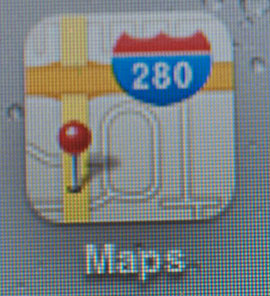 |
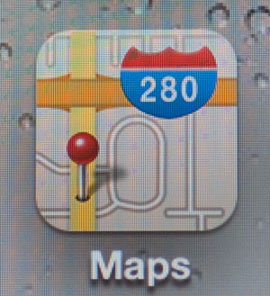 |
|
iPhone 3GS
|
iPhone 4
|

Text on the Google Nexus One

Text on the iPhone 4
The dot pitch is truly remarkable, so much so that Apple makes the claim that their display outresolves the human eye; its advertised ability to do so has earned it a new Apple tradename, "retina display."
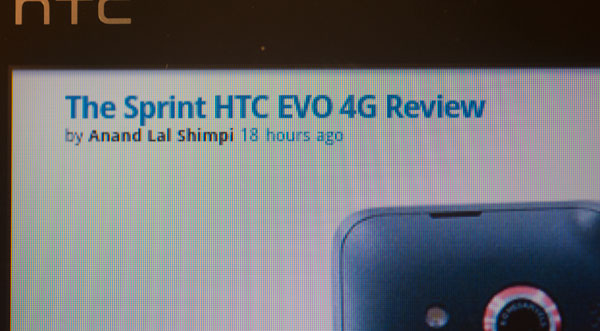
Text on the HTC EVO 4
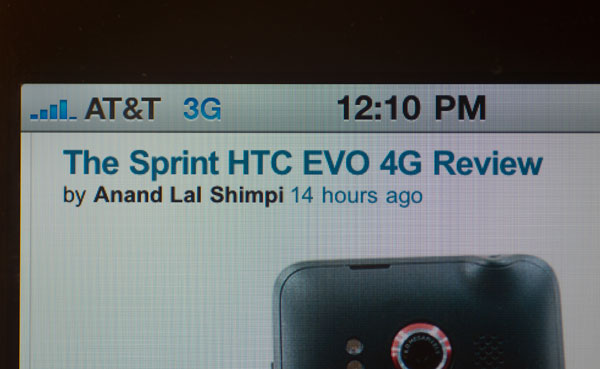
Text on the iPhone 4

AnandTech Logo on the EVO 4G

AnandTech Logo on the iPhone 4
Immediately after hearing Apple's claim that the Retina Display outresolves the human eye, I snapped into optics mode and crunched the numbers, and tweeted that the results were valid.
In the days that followed, there was considerable debate about the validity of Apple's claims. However, nearly all of the debate really just hinged on a debate over angular resolution of the human eye, and a little more over viewing distance. They're both entirely conventions.
As you've probably discovered by now, the human eye resolution can really only be characterized in angular subtense. Hold something closer to your eye, and you can see smaller features better (in theory), move it further away, and you can't make out small spatial details. The minimum angle visible with the human eye is the angle at which features (for the most common definition, a black and white square wave) stop being visible, and are indistinguishable from each other.
Most measures of visual acuity test with this implicitly - the Snellen eye chart's use of the capital "E" is literally a perfect example, which has given rise to a "tumbling E" eye chart. At twenty feet, the capital E subtends 5 minutes of arc, and conveniently has five half cycles of white to black (from top to bottom). So 20/20 implicitly implies an angular resolution of 1 arcminute (1/60 degrees).
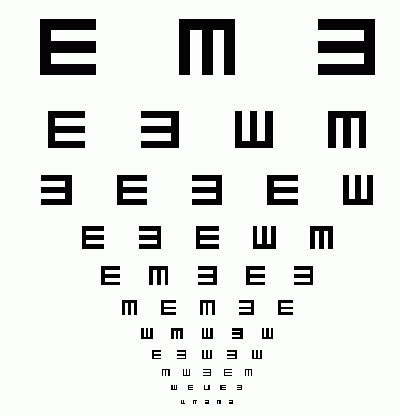
As an Optical Sciences and Engineering undergrad, I've had 1 arcminute drilled into my head more times than I can count as being the "normal" angular resolution of the human eye system. In practice, this is 20/20 vision, which is "normal," yet not perhaps the absolute maximum for human perfection. We can play games of course and argue that a small subset of the population has better than normal uncorrected vision, and thus an angular resolution of below 1 arcminute. I have above average uncorrected vision, which I've measured to be 20/15 on average, giving an angular resolution of approximately 0.75 arcminutes. Of course, the definitions stem from the spacing of cones in the fovea, the highest resolution part of the retina.
The other informational quantity needed to test the Retina Display claims is viewing distance. Again, there's a commonly agreed upon convention - standard viewing distance is considered to be 1 foot. This is another drilled into my brain number tossed around for comfortable viewing and reading. In practice, you can focus on objects much closer to your eye - this is called the near point and is often given as 10 inches, though as you get closer you increase strain aren't likely to keep it here.

Maybe not exactly the limit, but close enough.
Given the two most common standards tossed around, 1 arcminute and 12 inches, do the math out and you'll arrive at around 286 pixels per inch as the limit for eye resolving power, comfortably below the 326 on the Retina Display. Move to 0.75 arcminutes at 12 inches, and it's 382 pixels per inch, higher than the Retina Display. Honestly, I can't see the pixels at 12 inches.
Of course, the real story is even more complicated. Remember how the definition comes with the implicit assumption that we're dealing with a square wave pattern from white to black? That's a factor too - the contrast of the two pixels. Lower the contrast, and the eye's ability to pick out features decreases even more. So far, everything we've talked about has been first order, and without aberrations. Toss in spherical and astigmatism, two aberrations common to the eye system, and eye performance drops way more.
The human eye system is actually pretty poor, and shockingly easy to outresolve. In fact, if you saw the image your eye forms on your retina, you'd likely be appalled; it's your brain that makes the system usable. But at the end of the day, Apple's claims that the display outresolves the human eye are good enough for us.










270 Comments
View All Comments
Thorvald - Wednesday, June 30, 2010 - link
I understand that you aren't trying to stab at iOS4, but some of these really seem to be a stretch. For example, the iPhone 3G is just about two years old. What two-year old Android phone is running the latest OS with full feature parity as brand-new phones?I am quite sure that someone (with more time on their hands than me) could come up with an equally long list of points where Android falls short of iOS4, especially if we are going to be nitpicky about it.
It would be more nice if there were ways to objectively measure quality of user experience. Specific features are something that can be listed, but implementation counts too.
Spoelie - Wednesday, June 30, 2010 - link
You have to understand that that list was NOT originally compiled as a comparison to Android but was the negative part of a "what can you expect with this upgrade" (positives vs negatives) list. The iOS4 upgrade is offered on the 3G and that's why the point has merit: what does the upgrade mean for 3G users?However I concur it can read as a comparison since most of these points are Android features on SOME phones (social networking integration for example is mostly part of the proprietary custom UIs like HTC Sense and TouchWiz and not part of Android itself).
Personally, since I do have an Android phone, it reads more like a "what would I miss if I made the switch" list. But only some of the points.
darwinosx - Wednesday, June 30, 2010 - link
Thats a really idiotic list composed by someone who knows nothing about iPhones.-Anyone who wants flash on a mobile device is not paying attention.
-Comments on IOS4 on the 3G are silly. Especially since Apple says its not supported except on the 3GS and 4. Funny how they don't comment on how many Android phones are still on 1.6 and will never be upgraded including some pretty new phones.
-"True' multi-tasking? I don't think they understand how Android multi-tasking works. It's certainly not "true" multi-tasking as on a desktop os. It's also highly inefficient and a major cause of poor Android phone battery life.
-Android phones have widgets, which are intrusive and resource consuming because the stock Android OS UI is so awful.
-There are plenty of ways to USB mass storage with the iPhone.
-You can mass mark e-mails as read.
-There are plenty of ways to access the file system not that 99% of users will ever want to.
-You don't need vibration feedback when touching the screen because the iPhone screen, unlike many Android phones, actually reacts easily to touch.
-You can do bluetooth file transfers.
-SMS/MMS has multiple delivery notifications.
-I play Xvid and Divx all the time and there are multiple third party apps for that.
-You can add to the iPhone from other apps including Double Twist and others.
Truly an idiotic list.
bplewis24 - Wednesday, June 30, 2010 - link
Whether or not the list is idiotic, you just solidified your own standing with this post. I'm not sure why I even bothered posting to such an idiotic retort.Brandon
mesiah - Thursday, July 1, 2010 - link
lmao, not to sound like an android fanboy, or even an apple.... haterboy (hmmm new term there.) But your reasoning for alot of those missing features just further backs up the apple fan stereo type.Any time an apple device lacks a feature its because "That feature is not needed.' "That feature is useless." or how about "Anyone who wants ___ isn't paying attention."
But when the next gen phone comes out, and it finally does have those features. You know, the ones everyone else already had and you said you didn't need. You know, like... a camera. You then talk about how your new feature reinvents the phone its self. How "no one has ever done it like apple did."
Seriously, its pathetic. I know every phone out there has flaws. I also know there are plenty of things apple gets right with the iphone. I will even go as far to admit that smart phones wouldn't be where they are today if it weren't for the iphone. But you people need to admit when you are missing features you should obviously have simply because the all knowing Steve doesn't think you need them. But then again, coming from a company that can admit no wrong, even when their products have a serious design flaw such as the new antenna issue, I can't really expect the followers to act any differently than the ceo.
"If you want flash you aren't paying attention. If your reception went through the basement you don't know how to hold a phone. And if the AT&T network sucks its because you and all the other people are actually trying to use it."
strikeback03 - Thursday, July 1, 2010 - link
One of my friends on facebook posted a screenshot of one of iOS4's great new features......you can change your wallpaper. Really?
bregalad - Wednesday, June 30, 2010 - link
-There are two main reasons to keep Flash off mobile devices: battery life and mouse-overs, a commonly used Flash feature that doesn't work on a touch OS. Given the choice between incomplete support for a resource intensive plug-in and all-day usefulness I'll take that all-day battery life.-Multitasking approaches still up for debate
-iOS 4 runs slowly and lacks features on older hardware - agreed, but does Android do any better? Does your carrier even allow you to upgrade your OS or do you have to get a new phone?
-Given how much battery life iOS 4 stole from me I really wish there were quick toggles
-I don't live in any social network. I rarely even launch the facebook app.
-Something akin to home screen widgets would be very nice
-Every iPhone and iPod touch has the same sounds, it's terrible in an office with lots of them.
-Agreed on the mass marking as read
-Access to the file system is another thing Apple is philosophically opposed to. The iPhone is supposed to be an appliance not a computer.
-Early iPods had disk mode which was very useful. I wish Apple wouldn't be so inflexible.
-You want tactile feedback and all day battery life? Maybe next decade.
-File transfers assumes you have access to the file system and aren't trying to transfer DRM'd files. Not going to happen.
-I don't know about you, but I've never needed to mass delete contacts from any phone or computer. Do you suffer from multiple personality disorder?
-Better notifications of all types would be welcome.
-Smart dialling would be a good feature addition
-An app whose sole purpose is to play "illegally" downloaded files. Yeah, Steve's going to approve that one 'real soon now'.
-The dependency on iTunes is a philosophical one. Steve believes your computer is your digital hub, that it contains the master copy of all your stuff. By definition your phone, with its limited storage capacity, contains a subset of that data. I think that makes sense for the vast majority of the public. You're a niche Apple doesn't want to deal with.
Griswold - Wednesday, June 30, 2010 - link
Must be nonsenseday today.And before you say it, yes I got a 3G and I will replace it with a i4 when they're available around here instead of an android phone as I originally planned, but for other reasons than the fictional ones you just stated.
Bateluer - Wednesday, June 30, 2010 - link
Agreed, there are several Android phones that are out now that offer parity with the iPhone 4, and several within 2 months of release that will handily surpass it.As usual, Anand's reviews were very well written and detailed, but I'll still pit my year old Moto Droid against any iPhone product. :p
JAS - Wednesday, June 30, 2010 - link
As Anand pointed out in his review, the Google/Android operating system feels more like using a computer; and the iPhone (iOS 4) operating system feels more like an appliance. The Android OS is apt to appeal more to the geek than to the "normal mainstream consumer," just as Microsoft Windows is a favorite of people who like to tinker with their computers.For better or worse -- each person has to make their own judgment -- Apple's products are defined as much by features that are purposefully withheld as by the cool innovations that are added.